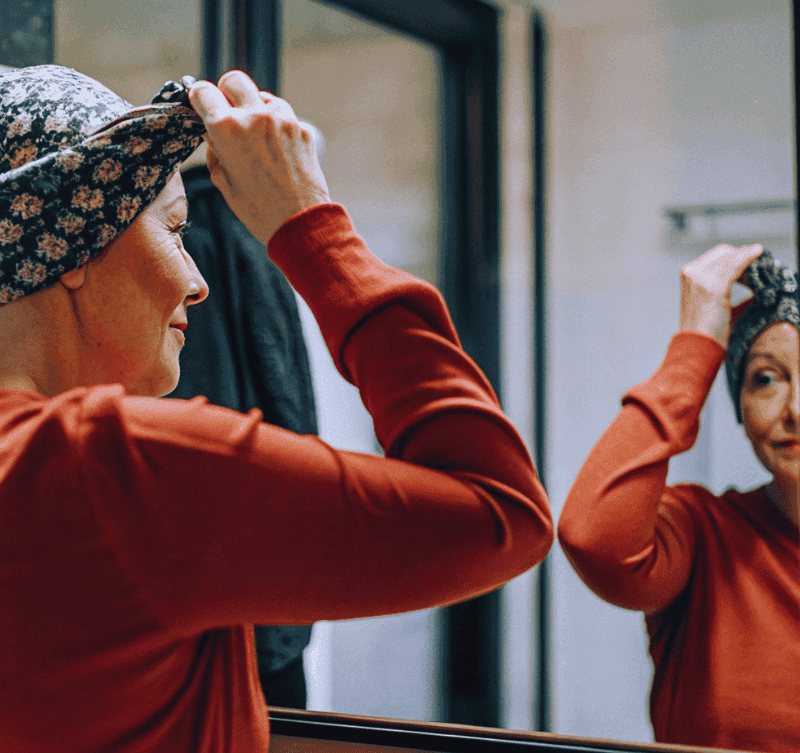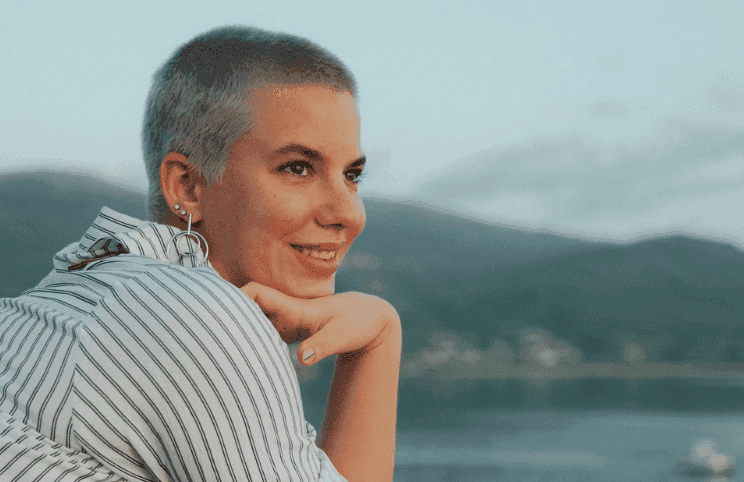Chemo Hair Loss in Breast Cancer: Tips to Manage Side Effects

Dr. Vrundali Kannoth•5 minutes•10 Oct 2025
Chemotherapy Hair Loss in Breast Cancer: How to Cope with Side Effects
Often, it starts with a few strands on the pillow. Then, more in the shower. And suddenly, the hair that felt like part of your identity begins to fall away.
Hair loss is one of the most visible and challenging side effects of chemotherapy for breast cancer. It's not just about appearance, but it feels like losing a piece of yourself and not having any control.
These emotions are entirely valid. But you or your loved ones undergoing such a period are not without support. There are practical ways to navigate this experience with more comfort and control.
Understanding hair loss due to chemo in breast cancer

Hair loss can show up in different ways for different people: mild thinning, patchy hair loss, or complete hair loss, which is also medically known as alopecia.
However, it's worth knowing that not all chemotherapy for breast cancer can cause hair loss. It depends on different factors, including:
- •Type, combination, and dose of medications
- •Treatment timing and frequency(weekly in smaller doses causes less hair loss than higher doses every three to four weeks)
- •Nutrition level and stress of the body
- •Other medical conditionslike thyroid disease.
Preparing for hair loss before treatment starts
Losing your hair during chemotherapy is one of the hardest parts of the treatment, no doubt. While you can’t always prevent it, there are ways to feel more prepared for these changes:
- •Talk with your care teamShare your concerns with healthcare providers openly. They can offer practical advice about what to expect with your specific treatment plan, suggest ways to reduce hair loss or connect with support resources for wigs. Most importantly, they understand your worry and can help prepare you physically and mentally.
- •Trim your hair yourselfMany people find it distressing to see clumps of hair on their pillow or their hairbrush. So, think about cutting the hair short or even shaving it completely before treatment begins. This way, when hair does begin to fall, the change won't feel as upsetting and gives you a sense of control.
- •Look for wigs, caps, and scarvesMany breast cancer patients find comfort in having a wig, which can boost self-confidence and make you feel more like yourself. There are also different varieties available, and you or your loved ones can try experimenting with different styles you might not have opted for otherwise. You can consider synthetic wigs for easy care or human hair wigs for more styling options.
- •Listen to other patients' storiesHearing how others handle hair loss can often bring a sense of comfort and help discover inner strength. So, connect with fellow patients through support groups or explore podcasts like “Dear Cancer, I’m Beautiful” by Melissa Berry, "Dose of Joy” with Joy Huber, and more. These personal journeys can offer everyday tips and also remind you that you're not alone.
Managing hair loss during chemotherapy treatment
While going through chemotherapy for breast cancer, try out these simple tips to feel more at ease as you go through the treatment.

- •Use scalp cooling capsCold caps or scalp cooling systems are hat-like devices filled with cold gel or liquid coolant to save some or most of the hair. By cooling the scalp, they restrict blood flow and limit the amount of chemotherapy that reaches hair follicles. It might not be effective for all types of chemotherapy, so ask your oncologist if it is suitable for your specific treatment.
- •Be gentle with your scalpUse mild, fragrance-free shampoos and lukewarm (not hot) water, but limit washing to no more than twice a week. If your scalp feels dry or irritated, apply a light moisturiser. Also, use a wide-toothed comb and avoid hair clips, barrettes, or elastic bands that can pull on hair.
- •Stay away from heat and chemicalsHeat and chemicals can cause additional hair loss during chemotherapy. So, hold off on using curling irons, straighteners, or blow dryers until your hair fully regrows. Similarly, you must avoid chemical treatments like colouring, perming, or products that can dry out your hair and irritate your scalp.
- •Protect your headConsider wearing a soft hair net at night or sleeping on a satin pillowcase to prevent hair from coming out in clumps while you rest. When outdoors, wear a hat or scarf in sunny weather to prevent sunburn, which can cause additional itchiness and flaking. During colder months, a warm cap or beanie will keep your head comfortable and protected.
How to better handle your emotions after hair loss?
Hair loss can bring up a mix of emotions - sadness, frustration, and even shock. Here's how to care for your emotional well-being while moving through this part of the journey.
- •Pamper yourself wellTake time to do something that makes you happy. You can take a walk in nature, treat yourself to a manicure or facial massage, try something new like a pottery class or revisit an old hobby. These moments of pleasure are important reminders that you're still you.
- •Find your comfort zoneSome find it easier to avoid mirrors during their period, while others improve their confidence by experimenting with makeup or stylish head covers. Find what makes you or your loved ones going through chemo feel good about, and make it a part of your routine.
- •Reach out for supportWhether you're going through treatment yourself or supporting someone who is, don't face these feelings alone. Reach out to a support group, therapist, or trusted friend who can simply listen. Often, saying your thoughts and worries out loud makes things better.
- •Start a journalWriting things down can be a gentle way to process emotions that often feel too big to express. Just write whatever you’re feeling on the paper - be honest about what’s going on. Most people use journals to reflect on difficult times as well as to track small wins or simply remind themselves they’re doing their best.
How to manage other chemotherapy side-effects?
Chemotherapy for breast cancer can cause more than just hair loss, it may also affect your energy, digestion, and body. But with a few simple changes to your routine, many of these side effects can be managed easily.
Fatigue
One of the most common side effects of chemotherapy is feeling constantly tired. So, here are some ways to manage fatigue:
- •Make a daily schedulethat covers essential activities, meal times, short breaks, and a consistent bedtime to manage your energy throughout the day.
- •Try light activitieslike walking or stretching for 10–15 minutes, to gradually boost energy.
- •Eat small, balanced mealswith protein, whole grains, fruits and veggies to keep your body well-nourished.
Digestive issues
Chemotherapy can affect your digestive system, causing diarrhoea, constipation, bloating or appetite changes. Here are some helpful tips to ease these digestive issues:
- •Eat five to six small mealsinstead of three large ones to ease digestion.
- •Drink plenty of fluidslike water, broth, herbal tea, or electrolyte drinks to stay hydrated.
- •Choose soft, mild foodsat room temperature if your appetite is low or digestion feels off.
Skin and nail changes
Some chemotherapy treatments can lead to skin darkening, dryness and itchiness. These changes are temporary, and there are simple ways to soothe your skin:
- •Clean skin with lukewarm waterand mild soap, then moisturise with fragrance-free cream.
- •Wear gloves when doing choresto protect your skin and nails.
- •Use sunscreen (SPF 30+)and wear loose, comfortable clothes when going outdoors.
Final thoughts

Hair loss is a common side effect of chemotherapy for breast cancer, but it is temporary. Talk with your care team about what to expect and how to prepare to make it easier to handle.
From scalp care and head coverings to emotional journaling and seeking support, there are many ways to manage both the physical effects and the emotional weight that comes with it. Even side effects like fatigue and digestive issues can also be managed with small lifestyle changes.
FAQs on hair loss due to chemo
Medicines like minoxidil can increase regrowth, but results will vary. It's essential to consult a doctor before using any hair growth product or supplement.
Yes, chemotherapy for breast cancer can affect all body hair, including eyebrows, eyelashes, and facial or body hair. The extent of hair loss depends on the specific drugs and dosage used during treatment.
Hair loss itself isn’t usually painful, but some can experience scalp tenderness or itching as the hair begins to fall out. But this discomfort is temporary and often eases after the shedding phase ends.
Hair usually starts growing back within a few weeks after treatment. However, it’s important to note that hair may grow with a different texture, colour, or thickness than before, but this often changes with time.
Table of Content
- Chemotherapy Hair Loss in Breast Cancer: How to Cope with Side Effects
- Understanding hair loss due to chemo in breast cancer
- Preparing for hair loss before treatment starts
- Managing hair loss during chemotherapy treatment
- How to better handle your emotions after hair loss?
- How to manage other chemotherapy side-effects?
- Final thoughts
